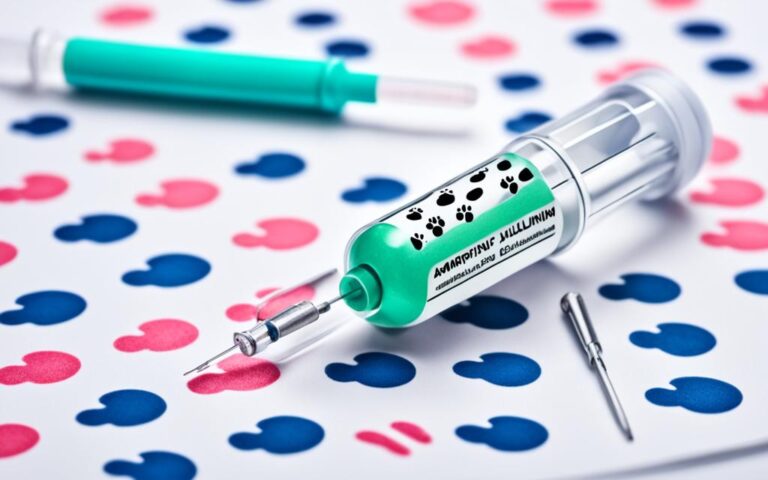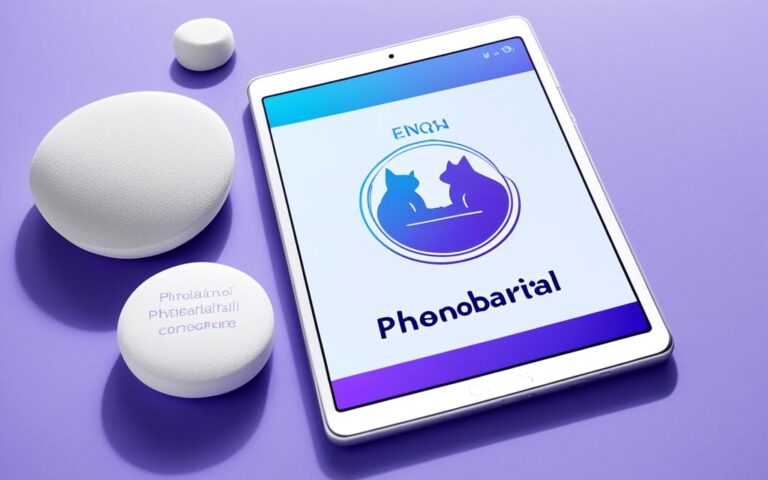Sotalol for cats: Uses and Side Effects
Sotalol is often prescribed to people with irregular heartbeats. Now, it’s making its way into helping our feline friends deal with fast heart rhythms1. This drug is a beta-blocker and an antiarrhythmic, a must-know for vets who need to treat cats with these issues. Before your cat takes sotalol, it’s important to know its uses, possible side effects, and what to be cautious about1.
Key Takeaways
- Sotalol is commonly used to treat abnormal heart rhythms in cats and other pets.
- The medication can take effect within 1-2 hours of administration2.
- Tiredness is the most common side effect of sotalol in pets2.
- Serious side effects include slow heart rate, collapse, weakness, and difficulty breathing2.
- Sotalol should not be used in pets with certain medical conditions or with certain other medications21.
Table of Contents
What is Sotalol?
Definition and Brand Names
Sotalol treats abnormal heart rhythms in pets like cats, dogs, and horses3. It’s known for use in people as Betapace® and in liquid form as Sotylize®. Yet, it’s not specifically approved for pets but can be used on a case-by-case basis by vets2.
Off-Label Use in Veterinary Medicine
Specials such as dogs with heart issues often get Sotalol from vets2. For pets, its use is considered “off-label.” This means it’s not the drug’s main use. But in vet medicine, it’s common to use drugs this way2. Remember, pet owners need to follow the vet’s advice. This is because how to give the drug and the dose can vary a lot from the human label.
Several studies look into Sotalol’s use in pets4. This includes work on heart issues in cats and dogs, and the best treatment for heart problems in Boxer dogs4. Even though it’s not okayed for pet use, its use for heart conditions is well-documented in vet practice4.
“Many drugs are commonly prescribed for off label use in veterinary medicine. In these instances, pet owners should follow their veterinarian’s directions and cautions very carefully as their directions may be significantly different from those on the label.”
Administering Sotalol to Cats
Dosage Forms and Directions
Sotalol is a common heart medication for cats. It comes in different forms for the cat’s comfort. The regular dose is 1-2.5 mg per kilogram, given twice a day5. You can give it as a pill or liquid. Sometimes, vets inject it, but this happens in the animal hospital.
When using the liquid, be very exact in measuring the dose5. It’s important that cats take sotalol on an empty stomach. Give it an hour before or two hours after meals5. But, if your cat vomits after taking it on an empty stomach, you can try giving it with a little food next time.
Sotalol takes about 1-2 hours to start working. But, you might not see big changes right away5. Your vet might want to do some tests, like ECGs or blood work. These check-ups help see how well the medicine is working on your cat’s heart and health.
It’s very crucial for you to follow all your vet’s instructions on how to give sotalol. This will keep your cat safe and help its heart condition. Good care and checking on your cat’s progress can make sotalol really effective for heart problems.
| Medication | Typical Dosage for Cats |
|---|---|
| Sotalol | 1-2.5 mg/kg, q12h |
| Amlodipine | 0.625-1.25 mg per cat, q12-24h |
| Aspirin | 1-2 mg/kg, q24h |
| Benazepril | 0.25-0.5 mg/kg, q12h or 0.5 mg/kg, q24h |
| Buprenorphine | 0.2-0.3 mls of injectable preparation per cat, for oral administration at home in emergencies |
| Clopidogrel | 18.75 mg per cat, q24h |
| Diltiazem (standard formulation) | 7.5 mg per cat, q8h for immediate-release; 30-60 mg per cat, q12-24h for sustained-release |
| Enalapril | 0.25-0.5 mg/kg, q12h or 0.5 mg/kg, q24h |
| Furosemide | 0.5-2.0 mg/kg, q12-24h for oral administration |
| Heparin unfractionated | 150-300 IU/kg SC q8h |
| Hydrochlorothiazide | 0.5-2.0 mg/kg, q12-24h for oral administration |
| Mirtazapine | 1.875 mg per cat, q24h for oral administration |
| Nitroglycerine (initial dosage) | 2-4 mg per cat, q6-8h for topical administration |
| Omega-3 Fatty Acids | Combination formulation of 1 gm (1000 mg) capsule per 5 kg body weight (or per cat) per day |
| Pimobendan | 0.625-1.25 mg per cat, q12h for oral administration |
| Rivaroxaban | Dose may vary depending on formulation available |
Learning how to properly use sotalol is key for pet owners. They should know the right dose and how to give it. This helps their cats fight heart rhythm problems. It’s all about making sure your cat stays healthy and happy567.
Missed Dose Guidelines
It’s important to give sotalol to cats exactly as your vet advises8. Missed doses can be risky. They might mean your cat needs drugs for longer or something stronger8. If you realize you missed a dose, give it right away. Then, wait for the next dose time8. And remember, never double up the doses or give more. That could harm your cat.
Being consistent with sotalol’s schedule is key to helping cats8. Missing a monthly dose could make your pet sick. They might have issues with their heart’s rhythm8. If they miss a pill and get bitten by a mosquito, it’s bad news. They could end up with heartworm disease8. So, do your best to follow your vet’s directions for giving sotalol. This way, your kitty gets the best care.
“Consistent administration of sotalol is crucial for maintaining the drug’s effectiveness and preventing potential health complications in cats.”

If you miss a sotalol dose, give it as soon as you can9. Then, get back to the regular times9. But sometimes, it’s better to just wait for the next scheduled dose, which is usually every 12 hours9. If you’re not sure what to do, ask your vet. They can give you the best advice for your cat.
Potential Side Effects of Sotalol in Cats
Sotalol is often used to treat heart rhythm issues in cats. But, it might lead to some side effects. It’s vital for pet owners and vets to know about these effects. This knowledge helps ensure the drug’s safe and effective use.
Common Side Effects
Sotalol may make cats feel tired or slow10. They could also feel a bit sick to their stomach. Usually, these issues are not too serious. And over time, the cat’s body might get used to the medicine.
Serious Side Effects
Sometimes, the side effects can be severe but this is rare. Cats might develop a very slow heart rate or weaken. They might find it hard to breathe, cough, or even faint. Loss of appetite is another sign to watch for10.3
3 There was a single reported case where sotalol led to a liver problem in a cat11. In that case, the cat showed symptoms like acute hepatitis after 12 weeks of using sotalol.
It’s worth mentioning that other beta-blockers can also sometimes harm the liver. But this issue with sotalol is not very common11. In most reports of drug-induced liver problems, sotalol was not often named as the cause11.
So, owners and vets should watch for signs of potential issues. If any reactions occur, they must be reported quickly. This helps keep the cat safe and well.
Knowing about sotalol’s side effects lets pet owners and vets work as a team. They can ensure the cat gets the right care. So, the cat’s health and life quality remain good121110.
Risk Factors and Precautions
Administering sotalol to cats needs careful attention from both owners and vets13. Sotalol can lead to QT prolongation in the EKG. This can cause serious or even fatal irregular heartbeats very rarely13. People with certain medical problems or who take drugs that might do the same have a higher QT prolongation risk.
Contraindications and Cautions
14 If a pet is allergic to sotalol or has certain health issues, like asthma, it should not receive it14. These problems include heart block, slow heart rate, uncontrolled congestive heart failure, or shock. For pets with managed heart failure, diabetes, kidney issues, or hyperthyroidism, use caution with sotalol.
Use in Pregnant or Lactating Cats
13 Using sotalol during cat pregnancy is only okay if truly needed because it might hurt the fetus13. For nursing cats, sotalol can get into the milk and harm the kittens. It is important to talk to a doctor if you’re breastfeeding and taking sotalol.
| Potential Risk Factors and Precautions with Sotalol |
|---|
|
15 Sotalol has special properties that help with heart issues15. These include blocking certain receptors and more prolonged action potential. Its effect on these receptors is not limited to the heart alone. The best results are usually seen when doses of 320 to 640 mg are used every day15. However, even at lower doses like 160 mg daily, it shows strong effects.
Drug Interactions with Sotalol
When giving sotalol to cats, both pet owners and vets need to watch out for drug interactions. It comes in generic and brand forms, like Betapace, Betapace AF, and Sorine16. This drug helps with heart rhythm problems that are very serious.
It’s important to use caution with several other drugs when your cat is taking sotalol. For example, be careful with amiodarone, some antibiotics, and many more. These can cause issues, so it’s good to be careful.
Doctors must think carefully about sotalol’s use in different people. This includes kids, older people, and those who are breastfeeding17. They also need to know that certain foods, alcohol, or tobacco might not mix well with sotalol.
| Medication | Potential Interaction with Sotalol |
|---|---|
| Amiodarone | Increased risk of abnormal heart rhythms |
| General Anesthetics | Potential for decreased heart rate and blood pressure |
| Antacids | Decreased absorption of sotalol |
| Antiarrhythmic Drugs (Class 1A, 1B, 1C) | Increased risk of abnormal heart rhythms |
| Azithromycin | Increased risk of abnormal heart rhythms |
| Calcium Channel Blockers | Potential for decreased heart rate and blood pressure |
| Cisapride | Increased risk of abnormal heart rhythms |
| Clarithromycin | Increased risk of abnormal heart rhythms |
| Clonidine | Potential for decreased heart rate and blood pressure |
| Cyclobenzaprine | Increased risk of abnormal heart rhythms |
| Digoxin | Potential for increased risk of abnormal heart rhythms |
| Diuretics | Potential for decreased heart rate and blood pressure |
| Erythromycin | Increased risk of abnormal heart rhythms |
| Fluoroquinolones | Increased risk of abnormal heart rhythms |
| Fluoxetine | Increased risk of abnormal heart rhythms |
| Lidocaine | Potential for increased risk of abnormal heart rhythms |
| Methimazole | Potential for decreased heart rate and blood pressure |
| NSAIDs | Potential for decreased heart rate and blood pressure |
| Phenothiazines | Increased risk of abnormal heart rhythms |
| Reserpine | Potential for decreased heart rate and blood pressure |
| Sympathomimetics | Potential for decreased heart rate and blood pressure |
| Tricyclic Antidepressants | Increased risk of abnormal heart rhythms |
Pet owners and vets must know about these drug interactions with sotalol. It’s important to stay in touch with the healthcare team. Following their advice and keeping an eye on your cat’s treatment are key.

Monitoring while on Sotalol
There’s no set monitoring for cats on sotalol18. But, vets might do an ECG. This checks if the medicine is working and the cat’s heart rate19.
Cat owners need to watch for serious side effects at home. Signs like slow heart rate, heart rhythm issues, or fainting are serious. Others include nausea, vomiting, or diarrhea19. Tell your vet about any other meds your cat takes19.
Vets may start sotalol at a low dose and increase it slowly19. They’re looking for the best dose for your cat. If sotalol doesn’t help after a few months, your vet might suggest a new plan19. Cats taking sotalol long-term might need more ECG checks19.
Dispose of unused sotalol properly. Never flush it down the toilet19. If your cat misses a dose, give it when you remember. But, don’t give two doses close together19.
In conclusion, vets don’t need to check cats on sotalol often. But, owners and vets should watch for side effects. This will help make sure the medicine is safe and works well1819.
Proper Storage of Sotalol
Keeping sotalol safe is key for helping your cat. It should stay at room temperature. This means between 68–77°F (20–25°C). Now and then, it’s okay if it gets a bit warmer or cooler, like from 59–86°F (15–30°C)20. Keep its container tightly closed. This stops the sotalol from getting wet or overexposed to light20.
For sotalol mixed by a pharmacy, follow their storage instructions. They might need different care compared to standard sotalol. Always check the label for how to keep it safe20.
Make sure kids and pets can’t get to the sotalol. This keeps them safe from possible harm. Bad storage, like too hot or too cold, or in the sun, can make the sotalol weak. This might not help your cat’s heart problem as well as it should20.
If you’re ever unsure about storing sotalol, ask your vet or the pharmacy. They can give you clear advice. Sticking to the storage tips means sotalol will work well for your cat20.
Emergency Situations and Overdose
Sotalol, a beta-blocker in vet medicine, is risky if overdosed21. Overdoses in pets, especially cats, are very dangerous. They need fast medical help21. Signs of overdose are panting, slow heart rate, and vomiting21.
If you think your cat has overdosed on sotalol, act fast. Call the vet, go to emergency care, or consult a poison control center right away21. Immediate and thorough care is needed. Sotalol’s safe line is thin, a bit too much is very harmful21. Treatment includes making your pet vomit, checking their heart and blood, giving IV fluids, and closely watching their condition21. In bad cases, insulin or IV lipids might be used21.
Accidental overdosing of heart meds like sotalol happens a lot, especially in areas with many seniors22. These meds can lead to serious troubles in pets, such as low blood pressure. Quick, right treatment is key to avoid dangerous issues22.
Sotalol Overdose: Symptoms and Treatment
- In a sotalol overdose, cats might pant, have a slow heart rate, or throw up21. They could also have low blood pressure or trouble breathing21.
- If overdose signs show, contact your vet right away or get emergency help21.
- The treatment includes making them vomit, checking vital signs, IV fluids, and monitoring with blood tests21.
- In bad cases, using high-dose insulin or IV lipids might be necessary21.
Sotalol is widely used by vets to manage certain heart issues in pets23. It’s typically given every 12 hours by mouth, 1-3 milligrams per kilogram. But, too much can cause serious problems like heart failure23.
It’s vital for pet owners and vets to be very careful with sotalol. Suspecting an overdose means quick emergency action to avoid severe harm21. Knowing the dangers and how to react fast is crucial for our pets’ safety21.
In summary, sotalol helps with certain heart diseases in cats but comes with risks. Learning about and preparing for potential overdoses is critical21. By working together with vets and sticking closely to their advice on use and monitoring, we can protect our cats21.
Sotalol for Cats: Uses and Side Effects
Sotalol is a heart medication used in cats for abnormal heart rhythms18. This drug is used even though it’s not specifically approved for cats2.
Dosages start at 1 to 2 mg/kg for cats, taken by mouth18. It’s often adjusted to find what works best. Sotalol treats tough heart problems like arrhythmias and atrial fibrillation in small animals, but more trial data is needed to show it’s better than other drugs18.
Side effects may include being tired, feeling sick, or throwing up2. In rare cases, cats might have a slow heart rate, collapse, feel weak, or breathe hard. They might also cough, pass out, or not want to eat2.
| Side Effect | Severity |
|---|---|
| Tiredness | Common |
| Nausea | Common |
| Vomiting | Common |
| Abnormally slow heart rate | Serious, Rare |
| Collapse | Serious, Rare |
| Weakness | Serious, Rare |
| Difficulty breathing | Serious, Rare |
| Coughing | Serious, Rare |
| Fainting | Serious, Rare |
| Lack of appetite | Serious, Rare |
Be careful if your cat has certain health problems before giving sotalol2. Also, watch out if they’re taking other drugs like amiodarone, digoxin, or NSAIDs2.
Don’t give an extra dose if you miss one, and don’t give more than is advised in a day19. Always throw away extra sotalol safely, not in the toilet or sink19.
Cats on sotalol need regular heart checks, including ECGs19. Remember, this medication is just for the cat it was prescribed for19182.
Comparison with Other Antiarrhythmic Drugs
Sotalol helps manage abnormal heart rhythms in cats as part of class II drugs24. There are other options like amiodarone, lidocaine, procainamide, and mexiletine24. The choice depends on the cat’s health, the type of arrhythmia, and the pros and cons of each drug.
Sotalol is given to cats every 12 hours in a dose of 1-3 mg/kg2425. Comparatively, lidocaine use means a slow injection between 0.25-0.5 mg/kg but followed by continuous infusion at 10-25 μg/kg/min if it works25. Procainamide, on the other hand, is slowly given over 20 minutes at 1-2 mg/kg25.
A study on Boxers with VPCs showed differences in medications’ effectiveness26. Sotalol and a mix of mexiletine and atenolol helped reduce VPCs and improved heart rate and arrhythmia severity26. However, procainamide and atenolol by themselves didn’t do as well in the study26.
Choosing the right medicine is critical for treating dangerous arrhythmias and lowering the risk of sudden cardiac arrest24. Sotalol, especially, is known to lower the frequency and severity of ventricular arrhythmias in cats and dogs24.
| Antiarrhythmic Drug | Dosage in Dogs | Dosage in Cats |
|---|---|---|
| Sotalol | 1-3 mg/kg q12h | 1-3 mg/kg q12h |
| Lidocaine | Bolus of 2 mg/kg IV, CRI 30-75 μg/kg/min | Bolus of 0.25-0.5 mg/kg, CRI 10-25 μg/kg/min |
| Procainamide | 5-15 mg/kg IV over 1 min, CRI 20-50 μg/kg/min | 1-2 mg/kg slowly over 20 min |
| Mexiletine | 4-8 mg/kg PO q8h | Not used in cats |
| Atenolol | 0.2-2 mg/kg q12-24h | 6.25-12.5 mg total dose per cat q12-24h |
| Amiodarone | 10-20 mg/kg PO q24h for 7-10 days, then 3-15 mg/kg PO q24-48h | Not used in cats |
Sotalol is often chosen by veterinarians for treating cats’ heart rhythm problems24. But they might use other drugs like amiodarone, lidocaine, procainamide, and mexiletine depending on what the cat needs24. The right choice is key to keeping the cat safe from sudden heart issues24.
Conclusion
Sotalol is very important for managing heart rhythms in cats. It’s not FDA-approved for pets, but vets use it off-label27. Pet owners need to talk with their vet about how to use it, its effects, and any precautions.
The info available shows how sotalol affects cats and its benefits28. It can help with certain heart issues like SVT. Still, more work is needed to know how well it treats hypertrophic cardiomyopathy.
When giving sotalol to their cats, owners must pay close attention for side effects. Working with the vet is key for using it safely and effectively for the cat’s health. Knowing about sotalol helps pet owners decide what’s best for their cats and team up with their vet for top care.
FAQ
What is Sotalol?
How is Sotalol used in veterinary medicine?
How is Sotalol administered to cats?
What should I do if I miss a dose of Sotalol for my cat?
What are the potential side effects of Sotalol in cats?
Are there any contraindications or precautions for using Sotalol in cats?
What interactions should I be aware of when giving Sotalol to my cat?
How should Sotalol be stored?
What should I do if I suspect a Sotalol overdose in my cat?
Source Links
- Sotalol for Dogs and Cats
- Sotalol | VCA Animal Hospitals
- Sotalol Compound | PetMart Pharmacy
- Sotalol in Cats (Felis) | Vetlexicon
- Management of the cat with heart failure
- Heart Disease: Conduction Abnormalities in Dogs and Cats – Heart Disease: Conduction Abnormalities in Dogs and Cats – Merck Veterinary Manual
- Does Missing a Dose of Your Pet’s Medication Put Them at Risk?
- Hydroxyzine For Cats: Uses, Side Effects, Dosage – GoodRx
- Sotalol Dose For Dogs & Cats | Vet Drugs List
- Sotalol – LiverTox – NCBI Bookshelf
- *
- Sotalol Oral: Uses, Side Effects, Interactions, Pictures, Warnings & Dosing – WebMD
- Atenolol | VCA Animal Hospitals
- DailyMed – SOTALOL HYDROCHLORIDE tablet
- Sotalol/Sotalol AF: Side Effects, Dosage, Uses, and More
- Sotalol (Oral Route) Precautions – Mayo Clinic
- Sotalol – an overview | ScienceDirect Topics
- Pet Factsheets – Crossriggs Veterinary Clinic
- Beta-blockers
- The top 3 human medications pets ingest in 2019
- Sotalol in Veterinary Medicine-Facts and Information | PetCoach
- Which Drugs Treat Ventricular Arrhythmias in Dogs & Cats?
- No title found
- Case Studies in Feline Cardiology – WSAVA 2019 Congress
- Pharmacokinetics of the β-Adrenergic Blocker Sotalol in Dogs







